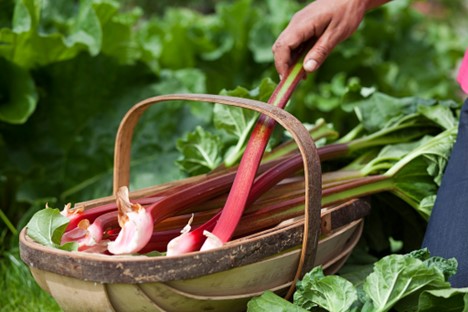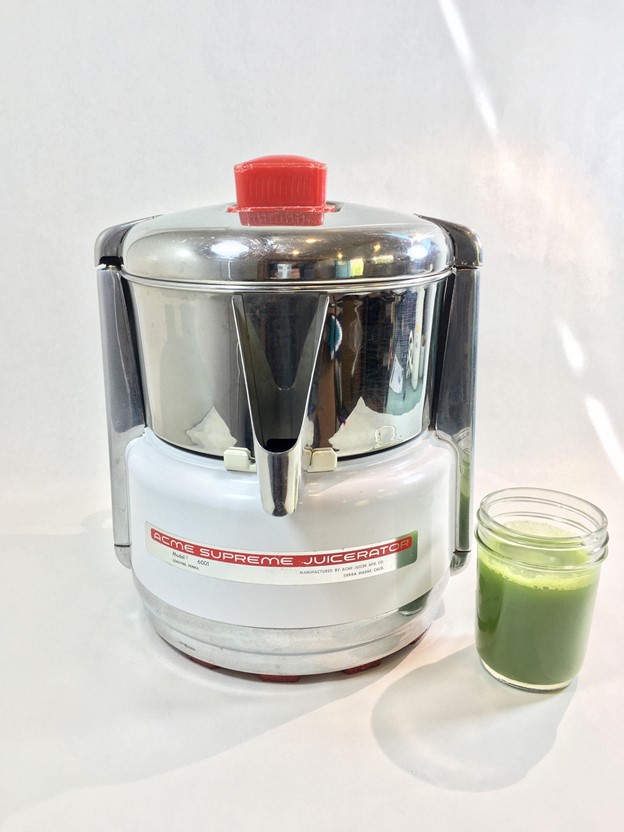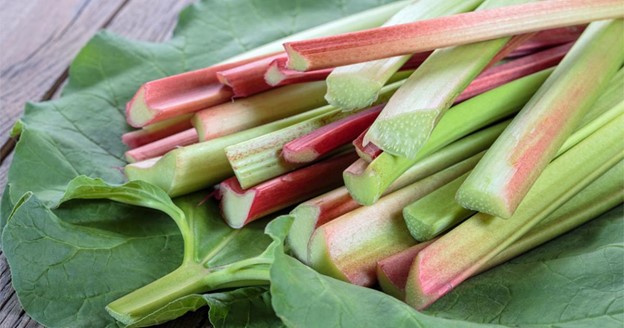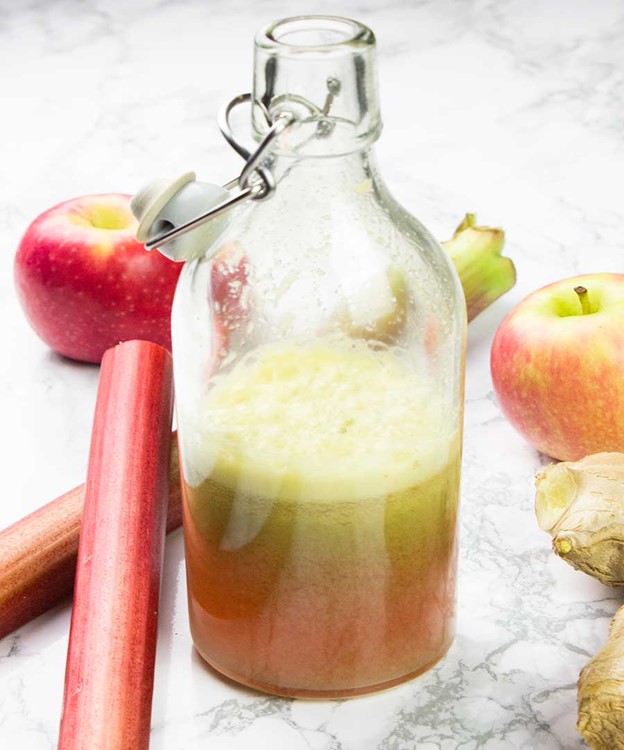One More Reason to Love this Prolific Plant!
I discovered something the other day. My daughter, Sarah, was visiting and we were cutting rhubarb for her to take home so she could make some pies. As we were harvesting, she said, “I wonder if this stuff could be juiced?”

There’s lots of information on the Internet on how to make a cooked rhubarb juice that is then mixed with sugar to make a drink similar to lemonade. But what about a raw rhubarb juice, would that work?
Well why not? We pulled out my Acme machine (which works on centrifugal force) and started juicing away. The fibrous stalks are challenging for a centrifugal juicer, but we did get some. A Champion juicer (a masticating, or slow juicer) would be the better machine for rhubarb, but we use what we have, right?

Anyway, this rhubarb juice had an unusual tart flavor (no surprise there). And since my rhubarb is green, the juice was a celadon green—very pretty. I’m guessing red rhubarb would juice with a soft pinkish color.
Being able to make raw rhubarb juice is a very cool discovery. Why? Because, as I’ve mentioned before, rhubarb is LOADED with health benefits. According to abundant scientific research, rhubarb is good for the heart, it promotes brain health, it helps keep your skin looking good, it strengthens your bones, it improves digestion, it reduces internal inflammation, it supports weight loss efforts, it helps protect against all cancers, it protects your vision, and all this because it’s bursting with antioxidants.

The thing is, once cooked rhubarb loses a lot of its potency. Yet as an uncooked juice, all these amazing health benefits remain intact. This fact alone is why being able to make raw juice from this remarkable plant is exciting!
But because it IS very tart, you probably wouldn’t want to drink it on its own. We experimented with mixing it into other fresh juices, and the results were good. Using a 1:1/2 ratio (1 part sweet fruit juice and ½ part rhubarb juice), we ended up with a slightly tart but pleasant version of the sweet fruit juice. Apple juice, or orange juice, or mango juice, etc. with an extra blast of vitamins, minerals, and antioxidants!

So going forward, I’m going to keep juicing it this season until my plant no longer produces. I’ll pour the juice into ice cube trays and freeze it. This way we’ll have raw rhubarb goodness that we can add to our smoothies and fruit juices throughout the fall and winter.
I hope all you rhubarb-growing Cook’n readers will seriously consider this idea. (Or if you’re not growing, but have a neighbor that does, see if he’ll let you mooch some.) Meanwhile, here’s one more reason to love this prolific plant!

There’s lots of information on the Internet on how to make a cooked rhubarb juice that is then mixed with sugar to make a drink similar to lemonade. But what about a raw rhubarb juice, would that work?
Well why not? We pulled out my Acme machine (which works on centrifugal force) and started juicing away. The fibrous stalks are challenging for a centrifugal juicer, but we did get some. A Champion juicer (a masticating, or slow juicer) would be the better machine for rhubarb, but we use what we have, right?

Anyway, this rhubarb juice had an unusual tart flavor (no surprise there). And since my rhubarb is green, the juice was a celadon green—very pretty. I’m guessing red rhubarb would juice with a soft pinkish color.
Being able to make raw rhubarb juice is a very cool discovery. Why? Because, as I’ve mentioned before, rhubarb is LOADED with health benefits. According to abundant scientific research, rhubarb is good for the heart, it promotes brain health, it helps keep your skin looking good, it strengthens your bones, it improves digestion, it reduces internal inflammation, it supports weight loss efforts, it helps protect against all cancers, it protects your vision, and all this because it’s bursting with antioxidants.

The thing is, once cooked rhubarb loses a lot of its potency. Yet as an uncooked juice, all these amazing health benefits remain intact. This fact alone is why being able to make raw juice from this remarkable plant is exciting!
But because it IS very tart, you probably wouldn’t want to drink it on its own. We experimented with mixing it into other fresh juices, and the results were good. Using a 1:1/2 ratio (1 part sweet fruit juice and ½ part rhubarb juice), we ended up with a slightly tart but pleasant version of the sweet fruit juice. Apple juice, or orange juice, or mango juice, etc. with an extra blast of vitamins, minerals, and antioxidants!

So going forward, I’m going to keep juicing it this season until my plant no longer produces. I’ll pour the juice into ice cube trays and freeze it. This way we’ll have raw rhubarb goodness that we can add to our smoothies and fruit juices throughout the fall and winter.
I hope all you rhubarb-growing Cook’n readers will seriously consider this idea. (Or if you’re not growing, but have a neighbor that does, see if he’ll let you mooch some.) Meanwhile, here’s one more reason to love this prolific plant!
 Alice Osborne
Alice Osborne
Weekly Newsletter Contributor since 2006
Email the author! alice@dvo.com
